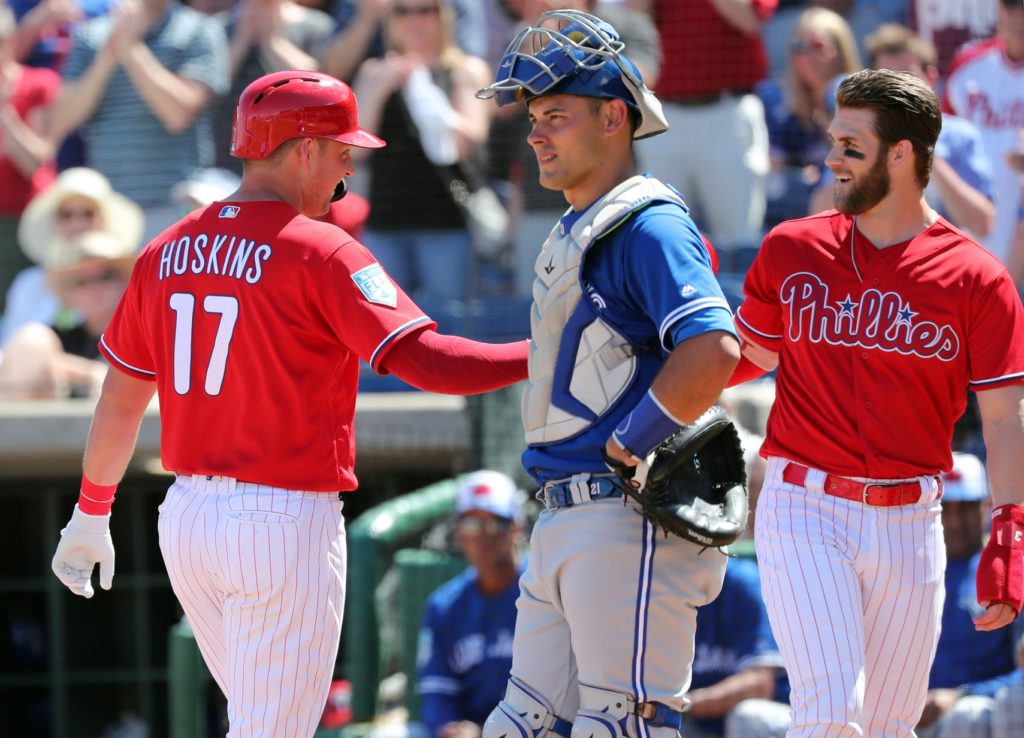Ad Disclosure
Rhys Hoskins and Bryce Harper Should Expect to See Some Four-Man Outfields This Season
By Bob Wankel
Published:

There’s been some buzz this spring about the possibility of Bryce Harper facing a four-man outfield at times this season. While still a relatively new defensive approach, a few teams infrequently utilized such an alignment last season. Typically, the four-man outfield is employed against left-handed hitters that:
- Are pull-heavy on the ground
- Hit a high volume of fly balls
For his part, Harper, who has never faced a four-man outfield in a regular season game, first hit against an opponent employing this approach when the Blue Jays did it in his Grapefruit League debut back on March 9. The Rays employed the same strategy two days later:
The Rays are using a four-man outfield against Bryce Harper. Blue Jays did the same thing on Friday. After that game Harper was asked if it’s troubling to him that teams might start playing him that way: “Man, I hope not.” #Phillies pic.twitter.com/A0jFZd5ny1
— Meghan Montemurro (@M_Montemurro) March 11, 2019
Weird. Real weird.
After the game, Harper was candid about the possibility of seeing a similar alignment once the regular seasons starts, “Man, I hope not. If they’re gonna start playing ball like that, it’s definitely different for sure.”
While a similar defensive approach against Harper may not be the norm this season, we should probably expect to see it on occasion given that he fits the above criteria. According to FanGraphs batted ball data, Harper’s 42.3% pull rate was 56th in baseball last season and his 38% fly ball rate was 50th among qualified hitters. While he’s not the obvious candidate for the four-man outfield shift that a player like Joey Gallo is, the data suggests he’s not going to hit many balls on the ground to the left side.
Interestingly, Harper isn’t the only Phillies hitter likely to see this alignment. According to Andrew Kyne of Sports Info Solutions, Rhys Hoskins is actually a better candidate than Harper to face a four-man outfield.
Although Hoskins is a right-handed hitter, his low percentage of non-pull side ground balls and line drives along with his high deep fly ball rate mean that he should probably expect to see it at some point early this season.
In fact, although a four-man outfield seems like a radical approach, it’s rooted in a defensive philosophy that isn’t exactly new to defending against Hoskins. Last May, the Dodgers employed a pull-heavy shift against Hoskins, essentially begging him to go the other way on the ground:
Dodgers using a heavy shift against Rhys Hoskins tonight. pic.twitter.com/tdcO2a5Swp
— Matt Breen (@matt_breen) May 29, 2018
If opposing teams elect to modify the approach with a four-man outfield, I would anticipate the first baseman would remain in a similar location to what we see above, while the third baseman may shade another step or two away from the line, and the shortstop would shift a few feet to the middle. Of course, no defensive alignment is full-proof and there would still be room for Hoskins to shoot a hard-hit grounder through the left side of the infield, something he’s capable of doing, and probably the main reason we won’t see the four-man outfield employed against him on a consistent basis. In this case, teams protecting against extra-base hits or holding multi-run leads that aren’t overly concerned with allowing a single could shift to this alignment.
And one other thing. If you’re expecting Harper to bunt down the third base line, or Hoskins to begin slapping balls the other way, you shouldn’t. Here’s what Hoskins said to The Inquirer’s Matt Breen:
It doesn’t make you do anything different, because as soon as you try to do something different, they win. If I’m trying to hit a ground ball to the right side, then they’ve done their job and I’m not doing mine. You don’t want me to bunt, I promise you.
That’s probably infuriating for the “hit it where they ain’t” crowd to hear, but Hoskins’ response is typical of most good hitters. A hitter going outside of his comfort zone, particularly while the high-level production is still there, can mess with his swing and lower his ceiling. Is that really worth a few extra singles through a vacated hole? I’d argue that it’s not, but it’s worth keeping an eye on how both Harper and Hoskins plan to attack these shifts moving forward.
Bob Wankel covers the Phillies for Crossing Broad. He is also the Vice President of Sports Betting Content at SportRadar. On Twitter: @Bob_Wankel E-mail: b.wankel@sportradar.com